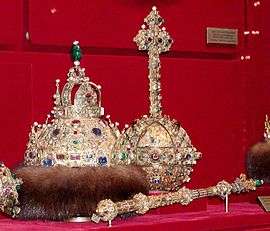Monomakh's Cap


Monomakh's Cap (Russian: шапка Мономаха, shapka Monomakha), also called the Golden Cap (Shapka Zolotaya), is a chief relic of the Russian Grand Princes and Tsars. It is a symbol-crown of the Russian autocracy, and is the oldest of the crowns currently exhibited at the Kremlin Armoury. Monomakh's Cap is an early 14th-century gold filigree skullcap composed of eight sectors, elaborately ornamented with a scrolled gold overlay, inlaid with precious stones (ruby and emerald) and pearls, and trimmed with sable. The cap is surmounted by a simple gold cross with pearls at each of the extremities. It is not to be confused with the Monomachus Crown in Budapest.
Origin
Its obvious Central Asian origin[1] (from ethnological or cultural point of view) has led some modern scholars to view the crown as a gift from Uzbeg Khan of the Golden Horde to his brother-in-law, Ivan Kalita of Moscow during the period of the Tatar yoke in Russia.[2] Boris Uspensky, in particular, argues that the Tatar headgear was originally used in coronation ceremonies to signify the Muscovite ruler's subordination to the khan.[1] According to Sergey Solovyov "after the death of Ivan Kalita all Russian princes traveled to the Horde... and the Khan announced the eldest son of Kalita, Simeon, the Grand Prince of Vladimir".[3] Also Solovyov writes that the first who introduced the coronation of the Russian monarch was Ivan III and it took place in 1498. At some point in the 15th or 16th century the crown was surmounted by a cross.
After Russia overcame the period of feudal fragmentation and Ivan III of Moscow and Vladimir asserted his position as successor to the Roman emperors, there arose a legend that the cap had been presented by the Byzantine emperor Constantine IX Monomachus to his grandson Vladimir Monomakh, the founder of the city of Vladimir and patrilineal ancestor of Ivan III. The legend was elaborated in The Tale of the Princes of Vladimir and served as one of the grounds for the "Moscow as the Third Rome" political theory. Accordingly, the crown became known as "Monomakh's Cap", the term first recorded in a Russian document from 1518. However the fact that Constantine IX Monomachus died 50 years before the coronation of Vladimir Monomakh makes the statement really a legend. The first version of the orient origin of the Cap (Uzbeg Khan) was arisen by George Vernadsky. Vernadsky was pointing to an interesting fact that according to Paul Pelliot Özbäg can be interpreted as a freeman (maître de sa personne).
Professor Kramarovsky who was specifically interested in the origin of the cap remarks that according to the technology of the headwear production the origin of the cap is either out of the Volga cities or Crimea where the school of Golden Horde filigree has developed. According to Aleksandr Andreevich Spitsyn possibly the cap was initially topped with the similar cross of the Jani Beg crown, however the German ambassador of the Holy Roman Emperor Maximilian I, Sigismund von Herberstein (notorious for his Notes on Muscovite Affairs) does not support that fact.
After Ivan the Terrible had himself crowned the first Russian Tsar with this headgear, the Polish king asked him to explain the meaning of his new title. To that Ivan replied that whoever is crowned with Monomakh's Cap is traditionally called a tsar, because it was a gift from a tsar (i.e., Constantine IX) who had sent the Metropolitan of Ephesus to Kiev to crown Vladimir Monomakh with this cap.[4] Ivan was presumably not aware that at the time of Constantine IX Monomachus' death, Vladimir Monomakh was only two years old and he was not the Kievan sovereign yet.
The Monomakh Cap was last used in the dual coronation of Ivan V and Peter the Great in 1682, though it was carried in the coronation procession thereafter. When Peter assumed the title of emperor, a new western-style crown was fashioned, but was not used in a coronation until that of Catherine I.[5]
See also
References
- 1 2 Uspensky, Boris. Assorted Works, vol. 1. Moscow, 1996. Pages 89-90, 107-111.
- ↑ Vernadsky, George. (1949). History of Russia. New Haven: Yale University Press.
- ↑ Solovyov, Sergey. "History of Russia from the Ancient times". Works in 18 volumes. Book II. Volume 3-4. Moscow, 1988. -page 240
- ↑ Solovyov, Sergey. History of Russia From the Most Ancient Times, in 15 volumes. Moscow, 1959-66. Vol. 3, page 516.
- ↑ Massie, Robert K. (2012). Peter the Great: His Life and World. New York: Modern Library. p. 61. Retrieved 2016-11-18.
External links
- Macro Photography The Crown of Monomakh
- Crown of Monomakh pictures and description
- The Crown of Monomakh at kreml.ru
- Tatar's hats - Crowns of the Ruthenian Tsars, based on the article "Crowns of Ruthenian Tsars - landmarks of Tatar Culture". magazine "Idel" #3/4, 1996.